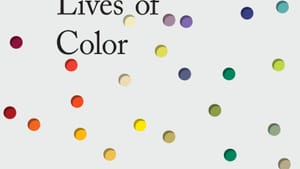Stay in the Loop
BSR publishes on a weekly schedule, with an email newsletter every Wednesday and Thursday morning. There’s no paywall, and subscribing is always free.
Hues you can use
‘The Secret Lives of Color’ by Kassia St. Clair

Do you think you know all about color? Or all you want to know? London-based author Kassia St. Clair might change that preconception. The Secret Lives of Color—published in New York in 2017 and London in 2016—is a treasure trove of colorful history, science, and first-rate storytelling that fascinates on every page.
Every shade has a story
I delightedly discovered St. Clair’s book late last year in the Delaware Art Museum shop, drawn to the volume's visually appealing binding (design by Britain’s James Edgar) covered with dancelike, 3D-looking trompe l’oeil dots. But it soon became apparent that the content was just as enticing.
You know you’re in good visual (and scholarly) hands with a book whose frontispiece quotes the great Victorian critic and artist John Ruskin: “The purest and most thoughtful minds are those which love color the most.” St. Clair goes on to prove Ruskin right (as he was about artistry, if not about life itself) in her witty, urbane, and tremendously interesting deep dive into 75 colorful tales.
Some hues chosen by the author (magenta or khaki, for instance) might seem common enough to have come from a Crayola box, but she soon dismantles that sense of familiarity. You may never have heard of some other colors, like gamboge or archil or mummy. But every shade has a story, and St. Clair tells them all masterfully.
Bears and horses; death, dusk, and dawn
The opening chapter of Secret Lives profiles seven kinds of white: lead white, ivory, silver, whitewash, chalk, beige, and isabelline. That last hue is named for a 17th-century queen, but now it’s cited mostly in a natural-sciences niche to describe animals like pale palomino horses, Himalayan brown bears, and the bird species Oenanthe isabellina. St. Clair’s exposition on “lead white” begins in a first-century-BC Korean tomb and spans centuries of artists (and women using white makeup) unwittingly poisoned when they used the color. As St. Clair states, “The pigment has seldom been a friend to the living.”
About green—verdigris, absinthe, emerald, Kelly, Scheele’s, terre verte, avocado, and celadon—the author quotes divergent opinions. The publication Arbiter Elegantiarum (1809) cautions against “that worst and vilest of all colors, pea-green.” But defending olive green in 2015, David Hockney said, “I don’t believe there are ‘off-putting’ colors.” And he should know—he certainly used them exuberantly. In her section on “acid yellow” (a color even Hockney might find off-putting), the author constructs and then deconstructs a history of the ubiquitous “smiley” emoji.
St. Clair also looks at seven favorite shades of pink: Baker-Miller pink, puce, fuchsia, shocking pink, fluorescent pink, amaranth, and Mountbatten pink—“a medium gray with a dash of Venetian red.” Evidently British naval commander and statesman Lord Mountbatten believed that this “dull, pucey color” would make ships almost disappear at dawn and dusk, the most treacherous times for naval attacks. Though Mountbatten repainted all the destroyers in his fleet, the British navy declined to go all the way with his color choice and phased it out in 1942.
Secret Lives of Color opens with six short, scholarly, acutely interesting essays, including “Chromophilia, Chromophobia: Politics of Color” and “Colorful Language: Do Words Shape the Shades We See?”
Many eager returns
The volume is also lovely to hold—perfectly sized and with an appealingly tactile cover. Each colorful profile (set in a welcoming typeface new to me, Kings Caslon) is just the right size for a quick, refreshing read. I frequently open it like a visual I Ching for a respite from, well, anything and everything.
Don’t be dismayed by its 320-page length. Slightly smaller in size than most reference tomes, it includes 20 pages of end notes (to access or not as you read); the usual acknowledgements and index; and a “Glossary of Other Interesting Colors” with 123 more St. Clair favorites like “eau de nile” and “incarnadine.”
The author—a speaker (here and in the UK), scholar, and essayist—writes for publications as varied as The Economist, Architectural Digest, Elle Decoration (the UK edition of Elle Décor), and The Times Literary Supplement. She was shortlisted for the Somerset Maugham Award (given to young British writers), and St. Clair is heard regularly on radio. Her newly published volume, The Golden Thread, posits how fabrics have changed history, and I’m reading that now. But for a palette of interesting colors backed up with sound scholarship and lightened with a dash of historical gossip, I return eagerly—and all the time—to The Secret Lives of Color.
What, When, Where
The Secret Lives of Color. By Kassia St. Clair. New York: Penguin Books, 2017. 320 pages, hardcover; $20. Get it here.
Sign up for our newsletter
All of the week's new articles, all in one place. Sign up for the free weekly BSR newsletters, and don't miss a conversation.

 Gail Obenreder
Gail Obenreder